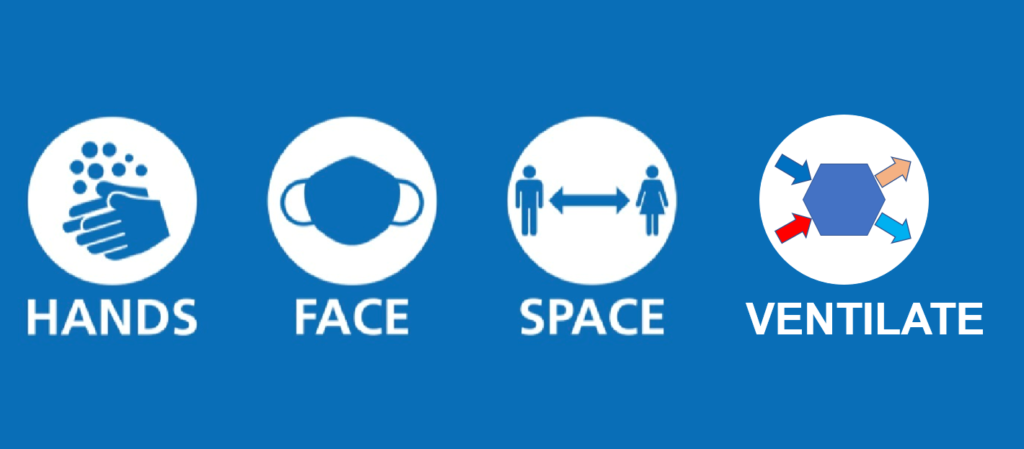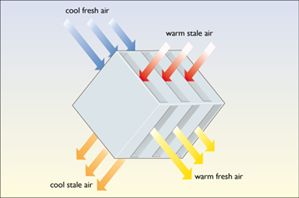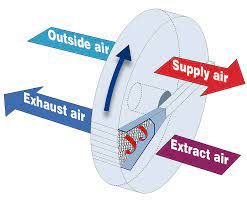We have all become accustomed to the “Hands Face Space” slogan, but with the easing of lockdown and the go ahead to meet other households indoors again we really need to consider how to appropriately ventilate our indoor spaces.
When the pandemic began in the UK back in January 2020 the focus to help protect each other from the virus was on what were believed at the time to be the most likely routes to infection:
- Hands – Washing hands effectively, to reduce risk of transmission through contact with contaminated surfaces.
- Face -Wearing face coverings to reduce the spread in volume and ferocity of spray droplets carrying infectious pathogens.
- Space – To reduce the risk of contamination from being in close contact with others, through either touch contamination or inhalation of respiratory droplets.
But growing evidence and research suggests there is an even greater risk posed by the transmission of coronavirus via aerosols. Unlike the respiratory droplets which are heavier and therefore drop faster over shorter distances, these fine aerosol droplets dry quickly and are small enough to remain suspended in the air from minuets to hours and research also suggest that these particles can be suspended in the air for up to 10 meters or more. Leading the WHO to change tact in May and acknowledge the risks posed by airborne transmission. Therefore, poorly ventilated crowded spaces will directly lead to an increased risk of infection and spread amongst the occupants within the space.

Ventilate
This is where ventilation comes into the mix. As the other mitigation measures are reduced i.e., the opportunity to remove masks inside, reduced social distancing, increased numbers of people etc… then the importance of getting the ventilation strategy right increases. The simple message being put out is to crank open the windows, either in a venting position all day or wide open for 10-15 minutes every hour. Where could this strategy fail? It relies on occupant intervention or the assumption that everyone can open a window and not be impacted in some way by noise, security, weather or pollution. For instance, as many as one in four UK homes is surrounded by air pollution which exceeds the safety limits set by the WHO, research analysis shows that road pollution affects virtually every part of Britain.
Long-term solution or short-term gain?
So, is this a realistic solution long-term? What about comfort, what about energy? At a time when we are all trying to get down a road to achieving zero carbon targets, can we afford to have uncontrolled, unrestricted air infiltration in our homes, schools and offices year-round? The year-round weather we have up here in Yorkshire would certainly suggest not!
Although what if we were to suggest that there is already a long-term solution? What if it is possible to ventilate a space to a set level of air changes whilst retaining a high percentage of efficiency in the heat exchange. A technology that has been around for decades and that can filter the incoming air to truly provide fresh air ventilation, as well as reduce energy losses and increase occupant comfort?
What about MEV? A technology that relies on air infiltration through a leaky fabric and trickle vents? What if we don’t have the adequate wind pressures? How many times have we visited family or friends and found all the trickle vents closed because they’d got fed up with the passing noise, drafts or insects? And most importantly can MEV guarantee us the recommended ventilation rates with all these exterior factors at play?
What if we had Mechanical Ventilation with Heat recovery (MVHR). Well. The good news is we do, and with good design and installation it offers a viable solution to the future issues we face. MVHR offers a solution not only in new build, but also for retrofitting into existing building stock and research undertaken by the Passivhaus trust proves that the installation of MVHR is beneficial for providing ventilation, improving comfort and reducing energy usage through varying levels of building standards.
How it works
MVHR works by extracting the stale warm air we generate indoors through activities such as cooking, showering and general lazing around and supplying tempered fresh air to habitable spaces such as bedrooms, home offices and lounges. The air is tempered through a heat exchanger contained within the unit. This passes the incoming and outgoing airstreams past each other transferring heat across and nothing else.

This is particularly true for the counterflow heat exchangers. There is still a certain amount of uncertainty around the effectiveness of Rotary wheel heat exchangers being 100% risk free from crossover contamination of incoming airflows. CIBSE highlight, to reduce the risk of airstream contamination in rotary wheel heat exchangers the system needs to be designed and installed by qualified engineers. The presence of a purge sector in these units can significantly reduce any crossover for additional security.

Another benefit of MVHR is the ability to maintain closer control of humidity levels and temperatures. Research undertaken by the Centres for Disease Control and Prevention (CDC) indicate that the survival time of the virus may be moderately reduced when relative humidity is maintained in the range of 40-60%. However, the more important aspect of humidity control is in preventing excessive dryness of the air, which can have a detrimental impact on the effectiveness of our immune systems to fight off viruses. However, a word of caution for those dwellings that have more bedrooms than people! MVHR under these circumstances may be running at higher rates than required, resulting in supplying overly dry air. To overcome this, moisture can be introduced through a standalone humidifier or via an enthalpy heat exchanger in the unit.

Air purifiers can be useful!
The MVHR will physically expel the infectious aerosols from a property. However, it will not destroy the airborne virus within an indoor space. The more people present in an enclosed area the higher the risk of contamination, for instance UK schools have some of the largest class sizes in the world! Several solutions will be required to maintain a reduced risk. However, we feel that MVHR should be the cornerstone of any energy conscious ventilation strategy.
Written by Paul Smith





